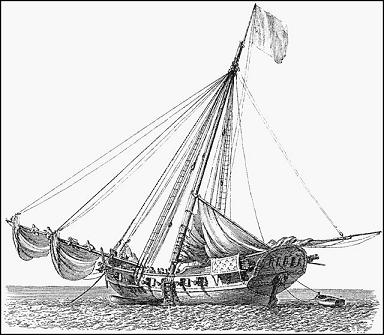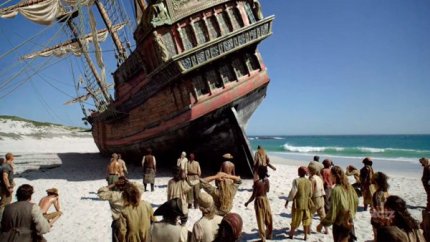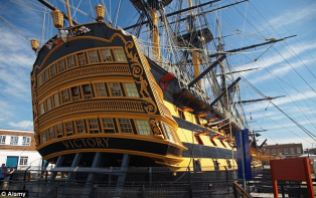Archive
The “golden age of piracy”
I guess most people watching Black Sails probably follow it for the boobs, blood and scowling. There’s plenty of each – Rackham’s charmingly incompetent, Silver’s charmingly hapless, Flint manages to get progressively less charming – slowly at first, then all at once. As character-driven drama it’s pretty much par for this “golden age of TV” – you can see that by turns it wants to be Game of Thrones or Boardwalk Empire but it’s just a bit too self-conscious about its basic trashiness.
But I’m sitting there thinking “I can’t take it any more, I need to know what year it is!” And so I finally look it up. And of course it’s 1715 – the obvious choice, to within 5 years either way. The moment we all know pirates from, due largely to Captain Charles Johnson’s popular trawl of the Newgate broadsheets* and, less directly but more fundamentally, to Henry Everie, Aurangzeb and the East India Company. You can read all about it in Robert Ritchie’s Captain Kidd and the War against the Pirates, which is very good at tying all the various kinds of extortion together.
It’s the time when most of our favourite characters come together (Blackbeard, Roberts, Low, England, Rackham and his titillating 3-way with Anne Bonney and Mary Read – and we know them all because of Johnson). It’s also the elegiac last gasp for “golden age” piracy, so we can place a reassuring capstone on it. Interesting times.
And I was vaguely disappointed because I was hoping somebody would’ve thought of setting things outside this critical decade – at some point when buccaneers were first abandoning their shoreline barbecues and getting up in Johnny Spaniard’s fries. Because goddammit Flint might want to copy Henry Avery and settle one big score, but his long game is pure Captain Morgan… or more exactly a royalist alternative American Revolution. And I was assisted in this misapprehension by Flint’s ship,
which could easily date from 1660, looking exactly like a warship of the Second Anglo-Dutch War:
(Flint’s Walrus, left, Isings’s war council before the 4 days’ battle, 1666, right.
BTW you can click on the pictures for full size. I finally figured out where wordpress hid that in their new interface).
And this misapprehension is actually quite lovely, because it is entirely plausible to have an elderly trader/warship kicking around the colonial service and getting swiped by some pirate – even 60 years later, as the show’s timeline demands, bravo!
But then it’s been refitted with a wheel instead of a whipstaff, and that’s frankly a bit too up-to-date in 1715. I’ll let it go – wheels are familiar to the audience and the steering gear of wheels even makes an important plot point… fine.
But. The Ranger.
I don’t want to say The Ranger is quite out of period… I’d have to do some more research, but she looks an awful lot like a second-half-of-the-18th-century English East Indiaman or warship. Look how flush that deck is, the low sterncastle, the rounded counter. If she’s not simply anachronistic she must’ve come off the stocks at Deptford 6 months ago and somehow wound up in Charles Vane’s possession. Maybe he posed as a Royal Navy post-captain and heisted her right out of the Medway. That’s a series I’d like to watch (albeit with a different actor for Vane).
What am I looking at? Well, flatness of the deck for one thing (we know that pirates often cut off all the fore and sterncastles to make a big fighting surface, but this is clearly a factory-done job). And restraint in ornamentation. And again, the Walrus is lovely:
Look at the carved woodwork on that transom – pure 17th century flair – and it even looks like someone’s nicked all the gold leaf off it, which is perfect. But the Ranger is just painted beading, like Nelson’s Victory (1765) or the Belvidera (1809):
…of course this is nit-picking, especially since all the ships are wildly over-sized for our pirate brethren, whose historical models preferred small, nimble sloops for which it’s easy to find spare parts.

It’s funny to see businesswoman Eleanor Guthrie talking to the captains seriously about their running costs when they’re all sailing around in ships that strain colonial governments’ budgets – the squadron in Nassau bay could probably give the Royal Navy at Kingston a serious worrying.
Anyway as of episode 8 it’s a lot of tense, swashbuckling fun. Even if it’s weird that the pirates are so bad at sailing in moderately bad weather.
*Funnily enough in 1724, the year of Johnson’s publication, the biggest draw at Tyburn execution grounds was not a pirate but serial escape artist Jack Shepherd, who deserves his own place in your game.
Bonus links: Digital Domain did a bunch of the fx for Black Sails. The way they construct scenes is fascinating.
The inestimable Dirk Puehl retells Long Ben Every’s capture of the Ganj-i-Sawai here.
The Spanish Galleon that later becomes the Revenge is probably based on the Nuestra Senhora de la Concepcion y de las Animas (1690).
Cindy Villar‘s Pirates and Privateers pages are pretty great.
It is characteristic of the show that somebody makes a passing joke about a missing character that he’s probably gone to Port Royal to meet up with Avery – both are missing in 1715, Avery is presumed either to have disappeared into a respectable life god knows where or to have been killed by some murderhobo or to have been bilked out of his fortune by Devomnshire merchants (which would be typical of Devonshire merchants but there’s the problem of where the money would’ve gone from there). Port Royal sank into the sea like Sodom, Atlantis or Irem of the Pillars in the earthquake of 1692. And nobody comments or explains the joke.









